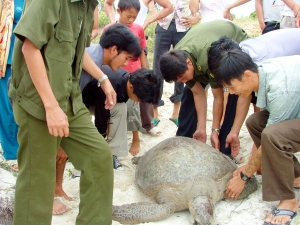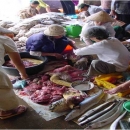Marine turtle poachers, traders, and buyers: what can be done?
Location: Hanoi, Viet Nam . 2nd Aug 2012
Historically, turtles have held deep symbolic meaning for the Vietnamese people. In pagodas, you can find sculptures of turtles with a crane on their back symbolizing the movable and immovable aspects of life. Perhaps the most famous turtles in Vietnam are the 82 stone turtles in the Temple of Literature in Hanoi, Vietnam’s first university established in 1070. As turtles live up to 100 years and have been around since the time of the dinosaurs, it is easy to understand why they are strongly linked to longevity, knowledge, and spirituality. But it is people’s beliefs about these animals that have led to their perilous decline.
Turtles help maintain the natural balance in the world’s oceans. Green turtles (Chelonia mydas) nibble the tips of sea grasses so that they grow faster. The new shoots provide habitat for juvenile crustaceans and fish and serve as nurseries for commercial fisheries. Leatherback turtles (Dermochelys coriacea) eat jellyfish and when the turtles disappear, jellyfish populations explode, invade beaches, and sting people, sometimes with fatal results. Jellyfish feed mostly on fish larvae and so fewer turtles results in higher predation of fish during the most vulnerable stage of their life cycle. Hawksbill turtles (Eretmochelys imbricate) mostly eat sponges. This helps to maintain the health and biodiversity of coral reefs because sponges can otherwise overgrow corals and suffocate reefs. Marine turtles are therefore important indicators of the health of marine ecosystems.
Marine turtles face enormous challenges during their long and complex life cycles. Out of every 1,000 eggs laid it is estimated that as few as one hatchling will survive to adulthood. Furthermore, marine turtles only become sexually mature between the ages of 15-50 years. As if these hurdles were not enough, if a female is disturbed as she nests, this may make her reluctant to nest again.
Five of the world’s seven species of marine turtle were relatively abundant in Vietnamese waters in 1941 when the first surveys were conducted. Today, the very few that do survive are nearly all Green turtles in Con Dao, which is home to more than 95% of all the nests found in Vietnam (about 300 nests/year). Con Dao, an island 100 km off the mainland, is one of the few coastal areas in Vietnam that hasn’t been heavily impacted by shrimp ponds and infrastructure development.
Habitat destruction, pollution, and by-catch (animals caught unintentionally when fishing) are among the main causes of the dramatic decline in marine turtle populations. WWF and IUCN have had some success introducing turtle excluder devices, or TEDs, and training fishermen how to release turtles that have been caught in their nets. According to the local NGO Education for Nature-Vietnam (ENV), between 2007 and 2011, the government seized 931 live turtles. Most of these were Hawksbills (873) followed by Green turtles (52). 849 of the Hawksbills were in the possession of a man who for 11 months had bought turtles from local fishermen, 5-10 animals at a time.
Poaching is the biggest threat to marine turtles in Southeast Asia. Having hunted out their home waters, poachers from Vietnam and China, now roam far into international waters and the territorial waters of Malaysia, Indonesia, and the Philippines. Most of the long-range Vietnamese vessels come from Quang Ngai Province in Central Vietnam.
In 2007, nearly 400 dead turtles were discovered by Indonesian authorities aboard a Chinese vessel. Over the past 10 years, more than a thousand poachers caught in the waters of Palawan in the Philippines alone have been arrested and fined. While jail sentences have been rare in the past, this may be changing. In 2010, 13 Vietnamese were sentenced to 18 months in jail in the Philippines after being caught with the bodies of 101 Hawksbill turtles.
Poachers and traders are generally aware of the illegality of the practice, but the trade is lucrative with a large Hawksbill worth over US$3,000, and the risk of detection very low. The combination of high reward and low risk is a powerful incentive to continue poaching and trading.
Since 2002, marine turtles have been legally protected in Vietnam but law enforcement has been very weak. For example, in July 2011, 102 dead turtles were seized in Binh Dinh Province. The local authorities refused to provide information about the seizure to conservationists and considered auctioning the turtles rather than destroying them as the law requires. ENV persuaded the authorities to cancel the auction.
Generally speaking, when marine turtles are found, they are confiscated, and, if still alive, released. But authorities are timid in dealing with wildlife offenders who are usually just given a warning. There has never been a single criminal prosecution for buying or selling marine turtles and the fines that have been imposed provide no disincentive: for example: US$250 for three turtles in Ha Long Bay in July 2006 and US$500 for 849 turtles in Nha Trang in September 2009.
In some cases, poverty drives poaching and it is not easy to persuade poor fishermen to stop. I recall an interview with a fisherman in Quang Ngai who said that he would continue poaching marine turtles as long as it brought in money since being in jail in the Philippines could not be worse than having no money for his family. Under these conditions, stricter law enforcement isn’t enough. It has to be accompanied by some form of alternative livelihood.
There is a high demand for marine turtle products for their medicinal, aphrodisiacal, and aesthetic values. Turtle meat and eggs are considered a delicacy, stuffed turtles are placed in the foundations of houses for good luck, wearing turtle products is claimed to lower blood pressure, and “bekko” jewellery and ornaments (made from the shell of Hawksbills) are widely sold in Southern Vietnam according to a report by TRAFFIC, the international wildlife trade monitoring network. In 2009, nearly 6,000 items were found for sale in 84 outlets in eight localities. Though there was a 74% reduction in the numbers of items since the previous survey in 2002 (when trade was prohibited in Vietnam), this may reflect that fact that there are fewer marine turtles in Vietnamese waters rather than a drop in demand.
In Vietnam, the most common buyers of bekko are Chinese and Taiwanese, followed by locals. Some buyers don’t know that these animals are endangered and that their purchase is illegal but most do, and simply don’t care. In fact, they may buy them specifically because of their rarity value. Under these conditions, awareness raising campaigns and stricter fines aren’t enough; exemplary prison sentences are required to send the clear and unequivocal signal that the purchase of endangered wildlife isn’t tolerated in Vietnam.


